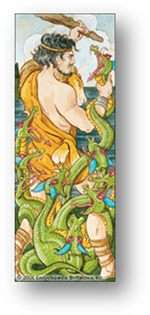THE
LIFE AND TIMES OF HERCULES
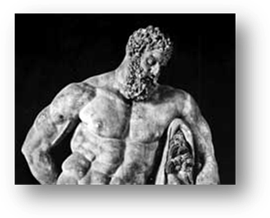
Unit Overview
Stories about the gods, called myths, were made up thousands of years ago. Was there a real Hercules, a man behind the stories? We will never know. Yet, his story is of a man who was so strong and courageous, whose deeds were so mighty, and who so endured all the hardships that were given to him, that when he died, Hercules was brought up to Mount Olympus to live with the gods.
Hercules was both the most famous hero of ancient times and the most beloved. More stories were told about him than any other hero. Hercules was worshipped in many temples all over Greece and Rome. In this unit, you will learn more about this hero.
Zeus and Alcmene
There are as many different versions of Hercules' life story as there are storytellers. Differences between the Disney movie version and other versions include the explanation of who Hercules' parents were, and why he had to perform the 12 Labors. Zeus, Hercules' father, was the most powerful of the gods. That meant Zeus could do anything he pleased, but it also meant that sometimes Zeus was not a very good husband to his wife, Hera, the queen of the gods.
Zeus fell in love with a beautiful Greek woman named Alcmene. When Alcmene's husband, Amphitryon, was away, Zeus made her pregnant. This made Hera so angry that she tried to prevent the baby from being born. When Alcmene gave birth to the baby anyway, she named him Herakles. (The Romans pronounced the name "Hercules," and so do we today.) The name Herakles means "glorious gift of Hera" in Greek, and that got Hera angrier still. Then she tried to kill the baby by sending snakes into his crib. But little Hercules was one strong baby, and he strangled the snakes, one in each hand, before they could bite him.
Hera remained angry. How could she get even? Hera knew that she would lose in a fight, and that she wasn't powerful enough to prevent Zeus from having his way. Hera decided to pay Zeus back for his infidelity by making the rest of Hercules' life as miserable as she could.
Eurystheus and the
12 Labors
When Hercules grew up and had become a great warrior, he married Megara. They had two children. Hercules and Megara were very happy, but life didn't turn out well for them. Hera sent a fit of madness to Hercules that put him into so great a rage that he murdered Megara and the children.
When Hercules regained his senses and saw the horrible thing that he had done, he asked the god Apollo to rid him of this pollution. Apollo commanded the hero to do certain tasks as a punishment for his wrongs, so that the evil might be cleansed from his spirit.
Hercules hurried to the temple where Apollo gave such advice. It was in the town of Delphi and was called the Delphic oracle. Apollo said that in order to purify himself for the spilling of his family's blood, he had to perform ten heroic labors (which would soon be increased to twelve).
Hercules got even more bad news. Apollo declared that he had to go to the city of Tiryns. The king of Tiryns was Eurystheus. Eurystheus had a reputation for being mean, and Hercules knew that the king would give him a tough time. The hero had to serve Eurystheus for twelve years while he performed the Labors. There was some good news, though. When the tasks were completed, according to Apollo, Hercules would become immortal. Unlike other men, instead of dying and going to the Underworld of Hades, he would become a god.
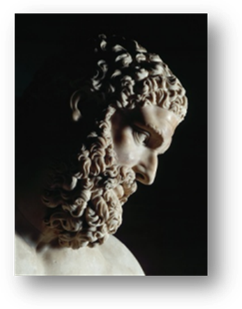
The Labors of
Hercules
As part of his sentence from the god Apollo, Hercules had to perform Twelve Labors, feats so difficult that they seemed impossible. Fortunately, Hercules had the help of Hermes and Athena, sympathetic deities who showed up when he really needed help. By the end of these Labors, Hercules was, without a doubt, Greece's greatest hero.
His struggles made Hercules the perfect embodiment of an idea the Greeks called pathos, the experience of virtuous struggle and suffering which would lead to fame and, in Hercules' case, immortality.
The Nemean Lion
Initially, Hercules was required to complete ten labors, not twelve. King Eurystheus decided Hercules' first task would be to bring him the skin of an invulnerable lion which terrorized the hills around Nemea.
The Nemean Lion was an animal that no weapons could wound. Hercules solved this problem by choking the animal. He then carried the huge carcass up on his back. He carried it into Mycenae.
When Hercules made it back to Mycenae, Eurystheus was amazed that the hero had managed such an impossible task. The king became afraid of Hercules, and forbade him from entering through the gates of the city. Furthermore, Eurystheus had a large bronze jar made and buried partway in the earth, where he could hide from Hercules if need be. After that, Eurystheus sent his commands to Hercules through a herald, refusing to see the powerful hero face to face.
The Lernean Hydra
The second labor was to go to Lerna and kill a creature with nine heads. This creature was called a Hydra. It lived in a swamp in Lerna. One of the heads was immortal. When one of the other heads was chopped off, two would grow in its place. Iolaus, Hercules’ nephew, helped him with this task. He brought Hercules a burning brand so that when he cut off one head, he would sear the neck so that another head could not grow back. When all of the heads had been chopped off, Hercules disposed of the immortal head by burying it securely under a large rock.
The Hind of
Ceryneia: Artemis’ Pet Deer
For the third labor, Eurystheus ordered Hercules to bring him the Hind of Ceryneia. Now, before we go any further, we'll have to answer two questions: What is a hind? Where is Ceryneia? Ceryneia is a town in Greece, about fifty miles from Eurystheus' palace in Mycenae. A hind is simply a female red deer.
You'd think it would have been easy for a hero like Hercules to go shoot a deer and bring it back to Eurystheus, but a few problems made things complicated. This was a special deer, because it had golden horns and hoofs of bronze. Not only that, the deer was sacred to the goddess of hunting and the moon, Artemis; she was Artemis’ special pet. That meant that Hercules could neither kill the deer nor hurt her. He couldn't risk getting Artemis angry at him; he was already in enough trouble with Hera.
Hercules set out on this adventure, and he hunted the deer for a whole year. At last, when the deer had become weary with the chase, she looked for a place to rest on a mountain called Artemisius, and then made her way to the river Ladon. Realizing that the deer was about to get away, Hercules shot her just as she was about to cross the stream. He caught the deer, put her on his shoulders and turned back to Mycenae. As Hercules hurried on his way, he was met by Artemis and Apollo.
Artemis was very angry because Hercules tried to kill her sacred animal. She was about to take the deer away from Hercules, and surely she would have punished him, but Hercules told her the truth. He said that he had to obey the oracle and do the labors Eurystheus had given him. Artemis let go of her anger and healed the deer's wound. Hercules carried it alive to Mycenae.
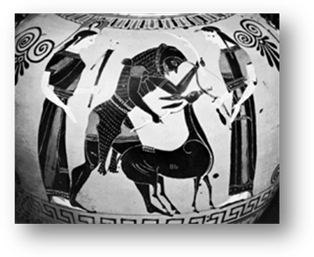
The Erymanthian
Boar
For the fourth labor, Eurystheus ordered Hercules to bring him the Erymanthian boar alive. Now, a boar is a huge, wild pig with a bad temper, and tusks growing out of its mouth.
This one was called the Erymanthian boar, because it lived on a mountain called Erymanthus. Every day the boar would come crashing down from his lair on the mountain, attacking men and animals all over the countryside, gouging them with its tusks, and destroying everything in its path.
It wasn't too hard for Hercules to find the boar. He could hear the beast snorting and stomping as it rooted around for something to eat. Hercules chased the boar round and round the mountain, shouting as loud as he could. The boar, frightened and out of breath, hid in a thicket. Hercules poked his spear into the thicket and drove the exhausted animal into a deep patch of snow. Then he trapped the boar in a net, and carried it all the way to Mycenae. Eurystheus, again amazed and frightened by the hero's powers, hid in his partly buried bronze jar.
The Augean Stables
For the fifth labor, Eurystheus ordered Hercules to clean up King Augeas' stables. Hercules knew this job would mean getting dirty and smelly, but sometimes even a hero has to do these things. Then Eurystheus made Hercules' task even harder; he had to clean up after the cattle of Augeas in a single day.
Now King Augeas owned more cattle than anyone in Greece. Some say that he was a son of one of the great gods, and others that he was a son of a mortal; whosever son he was, Augeas was very rich, and he had many herds of cows, bulls, goats, sheep and horses. Every night the cowherds, goatherds and shepherds drove the thousands of animals to the stables.
Hercules went to King Augeas, and without telling anything about Eurystheus, said that he would clean out the stables in one day, if Augeas would give him a tenth of his fine cattle.
Augeas couldn't believe his ears, but promised. Hercules brought Augeas's son along to watch. First the hero tore a big opening in the wall of the cattle-yard where the stables were. Then he made another opening in the wall on the opposite side of the yard.
Next, he dug wide trenches to two rivers which flowed nearby. He turned the course of the rivers into the yard. The rivers rushed through the stables, flushing them out, and all the mess flowed out the hole in the wall on other side of the yard.
The Stymphalian
Birds
After Hercules returned from his success in the Augean stables, Eurystheus came up with an even more difficult task. For the sixth Labor, Hercules was to drive away an enormous flock of birds which gathered at a lake near the town of Stymphalos.
Arriving at the lake, which was deep in the woods, Hercules had no idea how to drive the huge gathering of birds away. The goddess Athena came to his aid, providing a pair of bronze krotala, noisemaking clappers similar to castanets. These were no ordinary noisemakers. They had been made by an immortal craftsman, Hephaestus, the god of the forge.
Climbing a nearby mountain, Hercules clashed the krotala loudly, scaring the birds out of the trees, then shot them with bow and arrow, or possibly with a slingshot, as they took flight.
The Cretan Bull
After the complicated business with the Stymphalian Birds, Hercules easily disposed of the Cretan Bull.
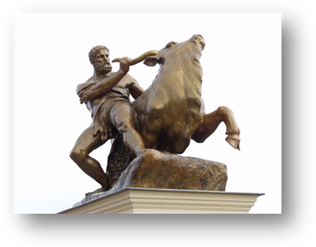
At that time, Minos, King of Crete, controlled many of the islands in the seas around Greece, and was such a powerful ruler that the Athenians sent him tribute every year. There are many bull stories about Crete. Zeus, in the shape of a bull, had carried Minos' mother Europa to Crete, and the Cretans were fond of the sport of bull-leaping, in which contestants grabbed the horns of a bull and were thrown over its back.
Minos himself, in order to prove his claim to the throne, had promised the sea-god Poseidon that he would sacrifice whatever the god sent him from the sea. Poseidon sent a bull, but Minos thought it was too beautiful to kill, and so he sacrificed another bull. Poseidon was furious with Minos for breaking his promise. In his anger, he made the bull rampage all over Crete, and caused Minos' wife Pasiphae to fall in love with the animal. As a result, Pasiphae gave birth to the Minotaur, a monster with the head of a bull and the body of a man. Minos had to shut up this beast in the Labyrinth, a huge maze underneath the palace, and every year he fed it prisoners from Athens.
When Hercules got to Crete, he easily wrestled the bull to the ground and drove it back to King Eurystheus. Eurystheus let the bull go free. It wandered around Greece, terrorizing the people, and ended up in Marathon, a city near Athens.
The Man-Eating
Horses of Diomedes
After Hercules had captured the Cretan Bull, Eurystheus sent him to get the man-eating mares of Diomedes, the king of a Thracian tribe called the Bistones, and bring them back to him in Mycenae.
According to Apollodorus, Hercules sailed with a band of volunteers across the Aegean to Bistonia. There he and his companions overpowered the grooms who were tending the horses, and drove them to the sea. But by the time he got there, the Bistones had realized what had happened, and they sent a band of soldiers to recapture the animals. To free himself to fight, Hercules entrusted the mares to a youth named Abderos. Unfortunately, the mares got the better of young Abderos and dragged him around until he was killed.
Meanwhile Hercules fought the Bistones, killed Diomedes, and made the rest flee. In honor of the slain Abderos, Hercules founded the city of Abdera.
Hippolyte's Belt
For the ninth labor, Eurystheus ordered Hercules to bring him the belt of Hippolyte. This was no ordinary belt and no ordinary
warrior. Hippolyte was queen of the Amazons, a tribe of women warriors.
These Amazons had nothing to do with the Amazon River in South America. Their name comes from a Greek word meaning "missing one breast." This is because an Amazon's right breast got in the way when she threw a spear.
The Amazons lived apart from men, and if they ever gave birth to children, they kept only the females and reared them to be warriors like themselves.
Queen Hippolyte had a special piece of armor. It was a leather belt that had been given to her by Ares, the war god, because she was the best warrior of all the Amazons. She wore this belt across her chest and used it to carry her sword and spear. Eurystheus wanted Hippolyte's belt as a present to give to his daughter, and he sent Hercules to bring it back.
Hercules' friends realized that the hero could not fight against the whole Amazon army by himself, so they joined with him and set sail in a single ship. After a long journey, they reached the land of the Amazons and put in at the harbor. When Hercules and the Greeks got off the boat, Hippolyte came down to visit them.
She asked Hercules why he had come, and when he told her, she promised to give him the belt. But the goddess Hera knew that the arrival of Hercules meant nothing but trouble for the Amazons. Disguised as an Amazon warrior, Hera went up and down the army saying to each woman that the strangers who had arrived were going to carry off the queen. So the Amazons put on their armor. The women warriors charged on horseback down to the ship.
But when Hercules saw that they were wearing their armor and were carrying their weapons, he knew that he was under attack. Thinking fast, he drew his sword and killed Hippolyte. Then he undid her belt and took it away from her.
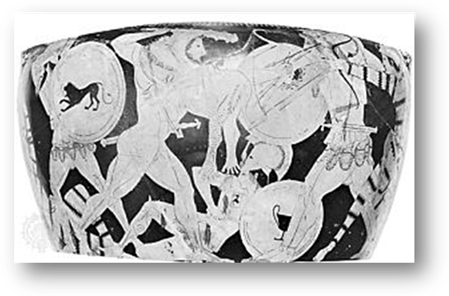
Hercules and the Greeks fought the rest of the Amazons in a great battle. When the enemy had been driven off, Hercules sailed away. After a stopover at the city of Troy, Hercules returned to Mycenae, and he gave the belt to Eurystheus.
The Cattle of
Geryon
To accomplish his tenth labor, Hercules had to journey to the end of the world. Eurystheus ordered the hero to bring him the cattle of the monster Geryon. Geryon was the son of Chrysaor and Callirrhoe. Chrysaor had sprung from the body of the Gorgon Medusa after Perseus beheaded her, and Callirrhoe was the daughter of two Titans, Oceanus and Tethys. With such distinguished lineage, it is no surprise that Geryon himself was quite unique. It seems that Geryon had three heads and three sets of legs all joined at the waist.
Geryon lived on an island called Erythia, which was near the boundary of Europe and Libya. On this island, Geryon kept a herd of red cattle guarded by Cerberus's brother, Orthus, a two-headed hound, and the herdsman Eurytion. Hercules set off on for Erythia, encountering and promptly killing many wild beasts along the way, and he came to the place where Libya met Europe. Here, Hercules built two massive mountains, one in Europe and one in Libya, to commemorate his extensive journey. Other accounts say that Hercules split one mountain into two. Either way, these mountains became known as the Gates or Pillars of Hercules. The strait Hercules made when he broke the mountain apart is now called the Strait of Gibraltar, between Spain and Morocco, the gateway from the Mediterranean Sea to the Atlantic Ocean.
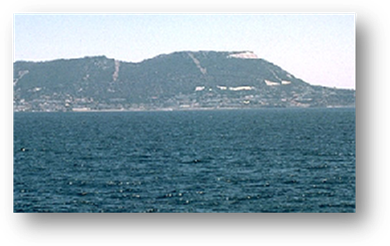
Hercules soon reached the island of Erythia. Not long after he arrived, Orthus, the two-headed dog, attacked Hercules, so Hercules bashed him with his club. Eurytion followed, with the same result. Another herdsman in the area reported these events to Geryon. Just as Hercules was escaping with the cattle, Geryon attacked him. Hercules fought with him and shot him dead with his arrows.
The stealing of the cattle was not such a difficult task, compared to the trouble Hercules had bringing the herd back to Greece. In Liguria, two sons of Poseidon, the god of the sea, tried to steal the cattle, so he killed them. At Rhegium, a bull got loose and jumped into the sea. The bull swam to Sicily and then made its way to the neighboring country. The native word for bull was "italus," and so the country came to be named after the bull, and was called Italy.
The escaped bull was found by a ruler named Eryx, another of Poseidon's sons, and Eryx put this bull into his own herd. Meanwhile, Hercules was searching for the runaway animal. He temporarily entrusted the rest of the herd to the god Hephaestus, and went after the bull. He found it in Eryx's herd, but the king would return it only if the hero could beat him in a wrestling contest. Never one to shy away from competition, Hercules beat Eryx three times in wrestling, killed the king, took back the bull, and returned it to the herd.
Hercules made it to the edge of the Ionian Sea, with the end of his journey finally in sight. Hera, however, was not about to let the hero accomplish this labor. She sent a gadfly to attack the cattle, and the herd scattered far and wide. Now, Hercules had to run around Thrace gathering the escaped cows. Finally, he regrouped the herd and, blaming his troubles on the river Strymon in Thrace, he filled the river with rocks, making it unnavigable. Then, he brought the cattle of Geryon to Eurystheus, who sacrificed the herd to Hera. The ancients don't tell us how long either Hercules or Europe took to recover from this eventful jaunt.
The Apples of the
Hesperides
Poor Hercules! After eight years and one month, after performing ten superhuman labors, he was still not off the hook. Eurystheus demanded two more labors from the hero, since he did not count the hydra or the Augean stables as properly done.
Eurystheus commanded Hercules to bring him golden apples which belonged to Zeus, king of the gods. Hera had given these apples to Zeus as a wedding gift, so surely this task was impossible. Hera, who didn't want to see Hercules succeed, would never permit him to steal one of her prize possessions, would she?
These apples were kept in a garden at the northern edge of the world, and they were guarded not only by a hundred-headed dragon, named Ladon, but also by the Hesperides, nymphs who were daughters of Atlas, the titan who held the sky and the earth upon his shoulders.
Hercules' first problem was that he didn't know where the garden was. He journeyed through Libya, Egypt, Arabia, and Asia, having adventures along the way. He was stopped by Kyknos, the son of the war god, Ares, who demanded that Hercules fight him. After the fight was broken up by a thunderbolt, Hercules continued on to Illyria, where he seized the sea-god Nereus, who knew the garden's secret location. Nereus transformed himself into all kinds of shapes, trying to escape, but Hercules held tight and didn't release Nereus until he got the information he needed.
Continuing on his quest, Hercules was stopped by Antaeus, the son of the sea god, Poseidon, who also challenged Hercules to fight. Hercules defeated him in a wrestling match, lifting him off the ground and crushing him, because when Antaeus touched the earth he became stronger.
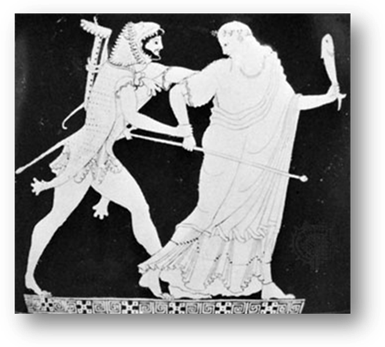
Nereus and Hercules
After that, Hercules met up with Busiris, another of Poseidon's sons, was captured, and was led to an altar to be a human sacrifice. But Hercules escaped, killing Busiris, and journeyed on.
Hercules came to the rock on Mount Caucasus where Prometheus was chained. Prometheus, a trickster who made fun of the gods and stole the secret of fire from them, was sentenced by Zeus to a horrible fate. He was bound to the mountain, and every day a monstrous eagle came and ate his liver, pecking away at Prometheus' tortured body. After the eagle flew off, Prometheus' liver grew back, and the next day he had to endure the eagle's painful visit all over again. This went on for 30 years, until Hercules showed up and killed the eagle.
In gratitude, Prometheus told Hercules the secret to getting the apples. He would have to send Atlas after them, instead of going himself. Atlas hated holding up the sky and the earth so much that he would agree to the task of fetching the apples, in order to pass his burden over to Hercules. Everything happened as Prometheus had predicted, and Atlas went to get the apples while Hercules was stuck in Atlas's place, with the weight of the world literally on his shoulders.
When Atlas returned with the golden apples, he told Hercules he would take them to Eurystheus himself, and asked Hercules to stay there and hold the heavy load for the rest of time. Hercules slyly agreed, but asked Atlas whether he could take it back again, just for a moment, while the hero put some soft padding on his shoulders to help him bear the weight of the sky and the earth. Atlas put the apples on the ground, and lifted the burden onto his own shoulders. And so Hercules picked up the apples and quickly ran off, carrying them back, uneventfully, to Eurystheus.
There was one final problem: because they belonged to the gods, the apples could not remain with Eurystheus. After all the trouble Hercules went through to get them, he had to return them to Athena, who took them back to the garden at the northern edge of the world.
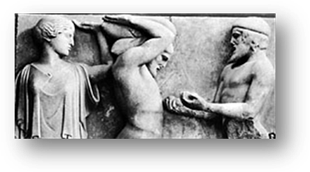
Cerberus
The most dangerous labor of all was the twelfth and final one. Eurystheus ordered Hercules to go to the Underworld and kidnap the beast called Cerberus. Eurystheus must have been sure Hercules would never succeed at this impossible task!
The ancient Greeks believed that after a person died, his or her spirit went to the world below and dwelled for eternity in the depths of the earth. The Underworld was the kingdom of Hades and his wife, Persephone. Depending on how a person lived his or her life, they might or might not experience never-ending punishment in Hades. All souls, whether good or bad, were destined for the kingdom of Hades.
Cerberus was a vicious beast that guarded the entrance to Hades and kept the living from entering the world of the dead. Cerberus was a strange mixture of creatures: he had three heads of wild dogs, a dragon or serpent for a tail, and heads of snakes all over his back
Cerberus' parents were the monster Echinda (half-woman, half-serpent) and Typhon (a fire-breathing giant covered with dragons and serpents). Even the gods of Olympus were afraid of Typhon.
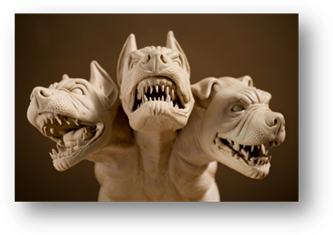
Before making the trip to the Underworld, Hercules decided that he should take some extra precautions. This was, after all, a journey from which no mortal had ever returned. Hercules knew that once in the kingdom of Hades, he might not be allowed to leave and rejoin the living. The hero went to Eleusis and saw Eumolpus, a priest who began what were known as the Eleusinian Mysteries. The mysteries were sacred religious rites which celebrated the myth of Demeter and her daughter Persephone. The ancients believed that those who learned the secrets of the mysteries would have happiness in the Underworld. After the hero met a few conditions of membership, Eumolpus initiated Hercules into the mysteries.
Hercules went to a place called Taenarum in Laconia. Through a deep, rocky cave, Hercules made his way down to the Underworld. He encountered monsters, heroes, and ghosts as he made his way through Hades. He even engaged in a wrestling contest! Then, finally, he found Hades and asked the god for Cerberus. The lord of the Underworld replied that Hercules could indeed take Cerberus with him, but only if he overpowered the beast with nothing more than his own brute strength.
A weaponless Hercules set off to find Cerberus. Near the gates of Acheron, one of the five rivers of the Underworld, Hercules encountered Cerberus. Undaunted, the hero threw his strong arms around the beast, perhaps grasping all three heads at once, and wrestled Cerberus into submission. The dragon in the tail of the fierce flesh-eating guard dog bit Hercules, but that did not stop him. Cerberus had to submit to the force of the hero, and Hercules brought Cerberus to Eurystheus. Unlike other monsters that crossed the path of the legendary hero, Cerberus was returned safely to Hades, where he resumed guarding the gateway to the Underworld. Presumably, Hercules inflicted no lasting damage on Cerberus, except, of course, the wound to his pride!
Further Adventures
of Hercules
After he completed the Twelve Labors, Hercules didn't just sit back and rest on his laurels. He had many more adventures. One was to rescue the princess of Troy from a hungry sea-monster. Another was to help Zeus defeat the Giants in a great battle for the control of Olympus.
Hercules on the
Pyre
Hercules got married a second time, to the beautiful Deianira. When Hercules was returning from his last adventure, Deianira gave him a welcome-home present. This was a cloak which she had woven herself. Deianira had a magic balm which a centaur had given to her. The centaur told Deianira that anyone who put on the balm would love her forever. But actually the balm contained a caustic poison. This balm she now smeared into the cloak.
When Hercules received the cloak and tried it on, his body immediately began to burn with excruciating pain. He tried to pull the cloak off, but the pain burned even harder and deeper. Death, thought Hercules, would be better than unendurable pain. Bellowing in agony, he asked his friends to build a huge pile of wood on the top of Mount Oeta. This would be Hercules' funeral pyre. He laid himself upon the pyre, and told his friends to light it. As the fire began to burn Hercules alive, the great gods looked down from Olympus. Zeus said to Hera that Hercules had suffered enough. Hera agreed and ended her anger. Zeus sent Athena to take Hercules from the pyre, and she brought Hercules to Olympus on her chariot.
|
|
Now answer
questions 1 through 48. |
Writing about
Literature
This unit told the story of Hercules and his Twelve Labors. Hercules had to complete the labors in order to gain forgiveness for his actions. Think of a time when you needed to gain someone’s forgiveness or correct a mistake you made. What events led up to your asking for forgiveness? Did you have to complete a series of tasks? Use the writing process to write a compare/contrast essay of five paragraphs comparing Hercules’ experiences with your personal experiences.
Begin by completing one of the gathering information tasks listed on the table below. The information gathering task should generate important details about the story of Hercules. It should also generate details about your personal experience.
|
Gathering Information Tasks |
|
|
Brainstorming |
A technique in which you come up with as many ideas as
possible on a subject |
|
Clustering |
A technique in which you break down a subject into smaller parts – Place the subject in the middle and circle it. Write related ideas around the subject, circling them and drawing lines to the subject. |
|
Asking Questions |
A technique in which these questions are used to gather
information: Who? What?
When? Where? Why?
How? |
|
Direct Observation |
A technique in which the writer relies on the five senses – sight, touch, smell, hearing, tasting. |
|
Indirect
Observation |
A technique in which the writer examines the experiences
of others by asking questions, watching, interviewing, etc. |
|
Imaging |
A technique in which the writer uses his imagination to generate ideas |
|
|
Now answer question
49. |
Once you have completed your pre-writing task, write an introductory paragraph for your essay. Remember that a successful introductory sentence should state the main idea of the paragraph. The introductory paragraph should set the stage for your essay.
Follow your introductory paragraph with the rough draft of the three body paragraphs of your essay. Each of these paragraphs should enhance and support the ideas presented in your introductory paragraph.
Finish your essay with a conclusion paragraph. The conclusion paragraph should bring the essay to a close. It should leave your reader with a sense of closure.
Continue work on your essay by self-evaluating and finding areas of weakness. Use the checklist below to work through the revision process with your essay.
|
Research Paper
Revision Questions |
||
|
YES |
NO |
|
|
|
|
Is the introduction interesting? |
|
|
|
Does the introduction explain
what the paper is about? |
|
|
|
Did you avoid using words like I and me in your introduction? |
|
|
|
Did you stick to your topic? |
|
|
|
Is the body of your paper
organized in a logical order? |
|
|
|
Did you correct run on and
fragment sentences? |
|
|
|
Are all the ideas clearly
explained? |
|
|
|
Have you limited each paragraph
to just one main idea? |
|
|
|
Did you write many different
kinds of sentences? |
|
|
|
Did you use descriptive words
throughout your paper? |
|
|
|
Have you combined short, choppy
sentences into longer, more mature-sounding sentences? |
|
|
|
Does the conclusion summarize
the important information from my paper? |
|
|
|
Have you taken out information
that you don’t need? |
Once you have revised your work, proofread essay, make any final improvements, and submit your final draft.
|
|
Now answer
questions 50 through 55. |
